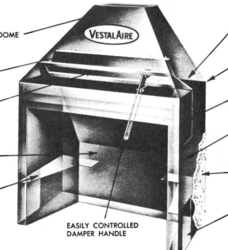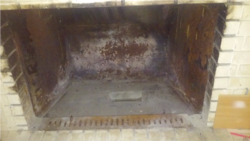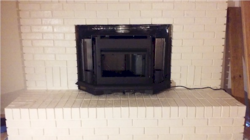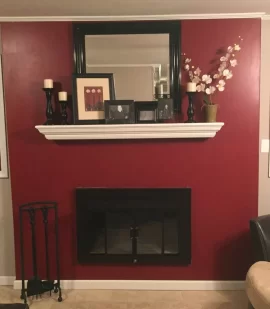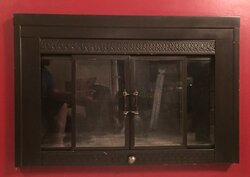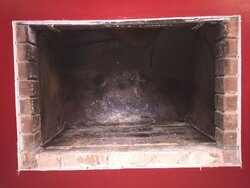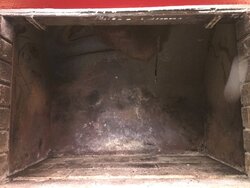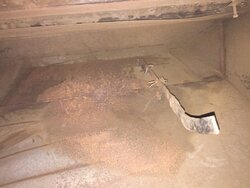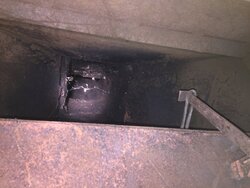Hello all... I am new to the forum and fairly new to fireplaces / chimneys etc. I am typically a DIY person so I am looking for some advice and will give as much background as possible to help you all understand what I've had done and what I am looking to do etc. I'm sorry as this is going to be pretty long.
Back in 2014 after moving into a home with my wife that she previously owned she inquired about being able to use the fireplace in our house (built in 1982). When she purchased the home there were some gas logs in the fireplace with a copper line making it look as though it were hooked up, however they were not, I believe they were in there simply for looks. So I removed the gas logs and started looking into how we could start using the fireplace. The fireplace had a brick bottom and metal walls with fireplace doors installed. The brick had been dry walled over and the drywall came up directly to the edge of the firebox. At the time the fireplace doors were installed so that they actually pulled up against the drywall. (I have no idea if the drywall is a special type used specifically for fireplaces or if that even exists and if so, how can I tell?) Anyway, lots of things just didn't seem right so I had called a somewhat local chimney sweep/inspector that I found by searching on the CSIA.ORG website to come out and do a sweep and inspection (I say local because the closest services are 45+ min from us). He sent one of his guys out to do the sweep and inspection and we got a good report back signing off saying that the fireplace was good to be used.
However, I was still leery of using the fireplace as the inspector said nothing about the drywall covering the brick and also said nothing about it coming up to the edge of the firebox. I was also leery because the previous owner of the house is the one that had done the remodeling and I'm leery to trust everything he has done due to seeing the results of some of his work I've seen first hand. I questioned if it was even approved by the local building inspector so then I called out the Iocal building inspector. After taking a look, even though the chimney inspector signed off on the fireplace, the local building inspector put quite a bit of doubt back into my mind about using the fireplace. He said at a minimum we needed to cut the drywall back so that the fireplace doors pulled up against the brick instead of pulling up against the drywall but even then he said he'd be leery of using the fireplace as it stood. He went on to tell me that he'd seen a similar fireplace burn 1/3 of a house down a month before due to a spark getting up in a wall of a house that was of similar age. That scared us enough to not use the fireplace that winter.
Last year I then called the chimney sweep/inspector and talked to him about my concerns and he agreed to come out and take a look at the fireplace and chimney again. He came out and after taking a quick look he told us he wouldn't recommend using the fireplace due to some warping of the existing metal firebox. This obviously raised lots of questions for me as a guy of his signed off on it a year prior and nothing had changed. However, I started some discussions with him about our options going forward. We had a few conversations about how to go forward to get the fireplace in a usable condition again but soon after we started those discussions the guy passed unexpectedly due to a heart attack. So here I am still in search of what to do.
As it is now, we have our fireplace that has a brick bottom and metal walls (that have some warping) with fireplace doors installed that pull up to the brick and drywall that comes directly up against the edge of the fireplace doors.
My wife and I have discussed installing a wood burning insert with a fan to give us heating in our basement where the fireplace is located. There is only baseboard heating down there that we try to keep off due to the cost of heating associated with it. By installing a wood burning fireplace we can avoid having to install a propane tank (which she is not too fond of having, due to it being an eye sore). She also wants something that the flame can been seen so that the ambiance of a fireplace is still present, and most importantly to me, with a blower we can heat the lower level of our house, let the heat rise, and we can cut our heating costs. We had come across the Osburn Matrix (Model OB02021) which she loved, but its pretty pricey.
So into the questions...
1) Is there a reliable chimney sweep / inspector in my area (zip 24382) that anybody knows of? I've contacted Blacksburg Chimney Services but all of their quotes seem VERY high.
2) What would I have to do to the existing fireplace to make it safe to use without an insert?
3) Are there other options out there that look similar to the Osburn Matrix (OB02021) from those of you that know the industry better that may be more affordable?
I don't have pictures right now but I can send some later.
Thank you to anybody in advance that can help me out.
Back in 2014 after moving into a home with my wife that she previously owned she inquired about being able to use the fireplace in our house (built in 1982). When she purchased the home there were some gas logs in the fireplace with a copper line making it look as though it were hooked up, however they were not, I believe they were in there simply for looks. So I removed the gas logs and started looking into how we could start using the fireplace. The fireplace had a brick bottom and metal walls with fireplace doors installed. The brick had been dry walled over and the drywall came up directly to the edge of the firebox. At the time the fireplace doors were installed so that they actually pulled up against the drywall. (I have no idea if the drywall is a special type used specifically for fireplaces or if that even exists and if so, how can I tell?) Anyway, lots of things just didn't seem right so I had called a somewhat local chimney sweep/inspector that I found by searching on the CSIA.ORG website to come out and do a sweep and inspection (I say local because the closest services are 45+ min from us). He sent one of his guys out to do the sweep and inspection and we got a good report back signing off saying that the fireplace was good to be used.
However, I was still leery of using the fireplace as the inspector said nothing about the drywall covering the brick and also said nothing about it coming up to the edge of the firebox. I was also leery because the previous owner of the house is the one that had done the remodeling and I'm leery to trust everything he has done due to seeing the results of some of his work I've seen first hand. I questioned if it was even approved by the local building inspector so then I called out the Iocal building inspector. After taking a look, even though the chimney inspector signed off on the fireplace, the local building inspector put quite a bit of doubt back into my mind about using the fireplace. He said at a minimum we needed to cut the drywall back so that the fireplace doors pulled up against the brick instead of pulling up against the drywall but even then he said he'd be leery of using the fireplace as it stood. He went on to tell me that he'd seen a similar fireplace burn 1/3 of a house down a month before due to a spark getting up in a wall of a house that was of similar age. That scared us enough to not use the fireplace that winter.
Last year I then called the chimney sweep/inspector and talked to him about my concerns and he agreed to come out and take a look at the fireplace and chimney again. He came out and after taking a quick look he told us he wouldn't recommend using the fireplace due to some warping of the existing metal firebox. This obviously raised lots of questions for me as a guy of his signed off on it a year prior and nothing had changed. However, I started some discussions with him about our options going forward. We had a few conversations about how to go forward to get the fireplace in a usable condition again but soon after we started those discussions the guy passed unexpectedly due to a heart attack. So here I am still in search of what to do.
As it is now, we have our fireplace that has a brick bottom and metal walls (that have some warping) with fireplace doors installed that pull up to the brick and drywall that comes directly up against the edge of the fireplace doors.
My wife and I have discussed installing a wood burning insert with a fan to give us heating in our basement where the fireplace is located. There is only baseboard heating down there that we try to keep off due to the cost of heating associated with it. By installing a wood burning fireplace we can avoid having to install a propane tank (which she is not too fond of having, due to it being an eye sore). She also wants something that the flame can been seen so that the ambiance of a fireplace is still present, and most importantly to me, with a blower we can heat the lower level of our house, let the heat rise, and we can cut our heating costs. We had come across the Osburn Matrix (Model OB02021) which she loved, but its pretty pricey.
So into the questions...
1) Is there a reliable chimney sweep / inspector in my area (zip 24382) that anybody knows of? I've contacted Blacksburg Chimney Services but all of their quotes seem VERY high.
2) What would I have to do to the existing fireplace to make it safe to use without an insert?
3) Are there other options out there that look similar to the Osburn Matrix (OB02021) from those of you that know the industry better that may be more affordable?
I don't have pictures right now but I can send some later.
Thank you to anybody in advance that can help me out.


